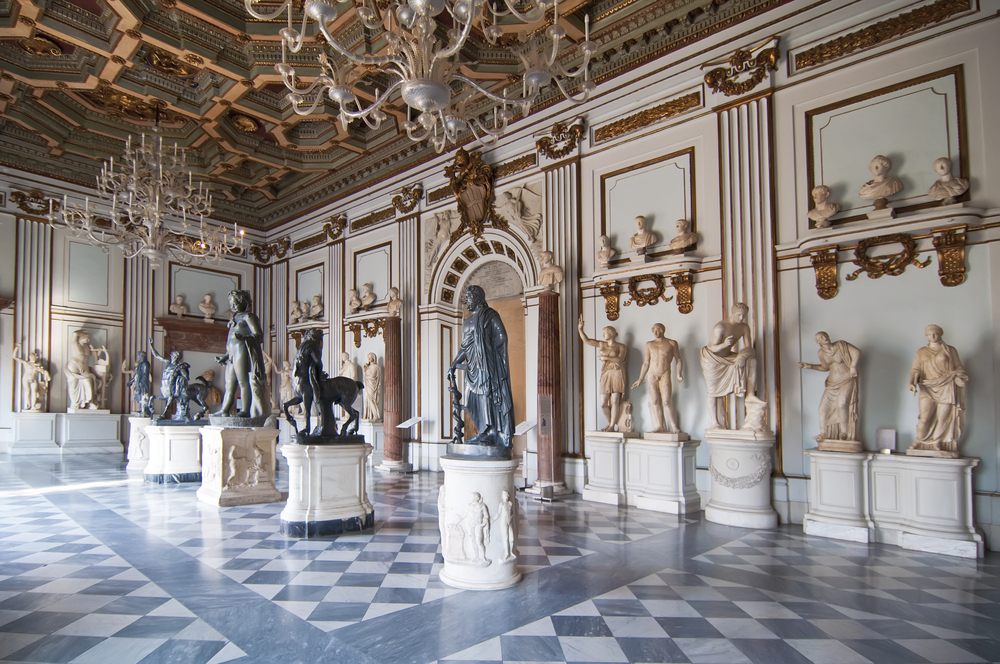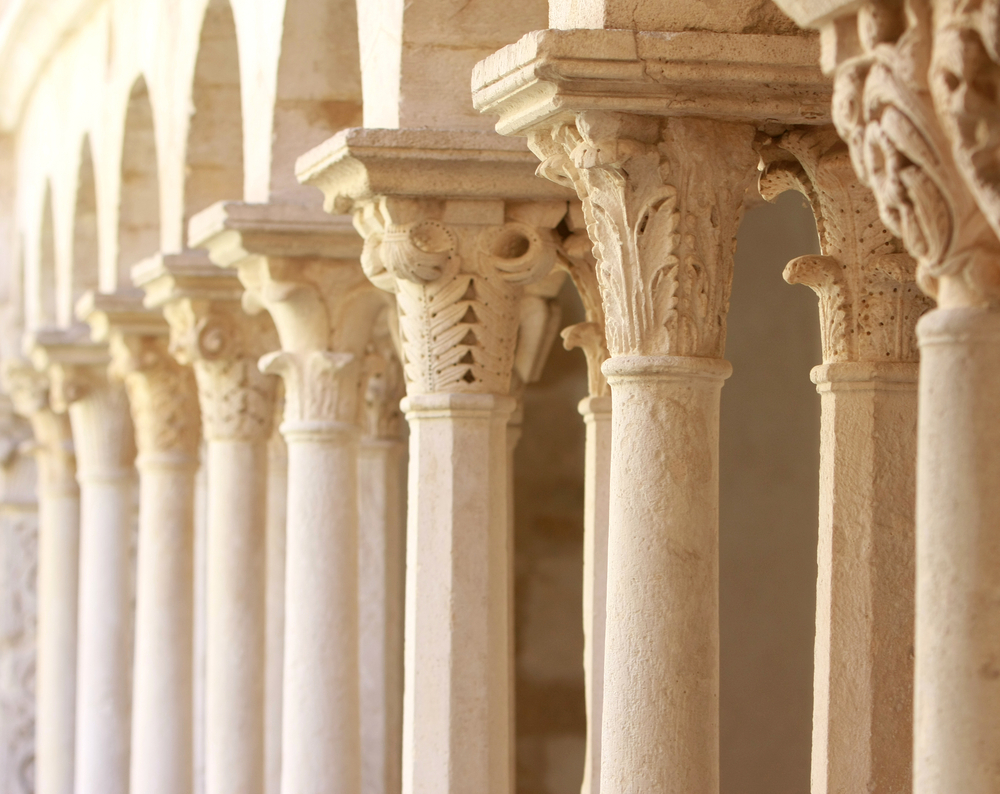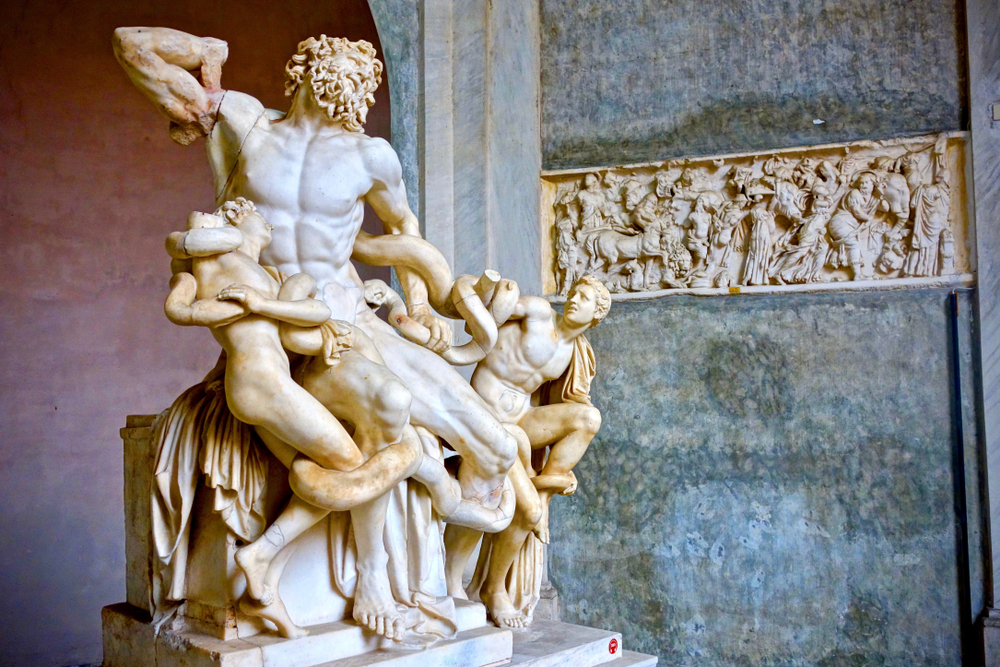Rainy days in Rome are the perfect time to discover the city's indoor wonders. When the weather turns wet, why not explore Rome’s incredible museums like the Vatican Museums or the Capitoline Museums, filled with masterpieces? For architecture lovers, the papal basilicas—St. Peter’s, St. John Lateran, St. Paul Outside the Walls, and Santa Maria Maggiore—offer breathtaking art and history under one roof.
You can also visit underground sites like the Catacombs or the Domus Aurea, Nero’s ancient palace. Prefer some retail therapy? Head to Rome’s top department stores, like La Rinascente, for high fashion and unique souvenirs.
For more ideas, check out our list of the 20 best things to do in Rome on a rainy day!
Ready to explore? Let’s go!
Ancient Sites
1. Pantheon

The Pantheon, an architectural marvel from ancient Rome, is one of the best-preserved monuments of its era. Built around 126 A.D. as a temple dedicated to all gods, it was later transformed into a Christian church known as the Basilica of Santa Maria Ad Martyres.
The most remarkable aspect of the Pantheon is its enormous dome, which is still the world's largest unreinforced concrete dome, featuring a central oculus that lets in natural light.
The harmonious proportions and the dynamic play of light and shadow inside will leave you in awe. The Pantheon stands as a brilliant example of Roman ingenuity and architectural excellence.
- Address: Pantheon, Piazza della Rotonda, 00186 Roma
2. Castel Sant’Angelo

Castel Sant'Angelo, initially constructed in 139 A.D. as Emperor Hadrian's mausoleum, is a towering cylindrical fortress that has played multiple roles throughout history, including a papal residence and a prison.
It is linked to Vatican City by the Passetto di Borgo, a secret passageway that adds an intriguing element to its history. The castle's terrace offers breathtaking views of Rome, and its interior houses a museum filled with artefacts and historical exhibits. With its rich history and striking architecture, Castel Sant'Angelo is a captivating destination.
- Address: Museo Nazionale di Castel Sant'Angelo, Lungotevere Castello, 50, 00193 Roma
3. Domus Aurea

The Domus Aurea, or "Golden House," was Emperor Nero’s vast and extravagant palace complex built after the Great Fire of Rome in 64 A.D.
Located on the Oppian Hill, near the Colosseum, this architectural marvel once covered over 300 acres with lush gardens, pavilions, and artificial lakes. Today, visitors can explore the underground ruins of the Domus Aurea, which reveal stunning frescoes, grand halls, and intricate mosaics that reflect the opulence of Nero’s reign.
Guided tours offer a glimpse into ancient Roman life and the emperor's luxurious lifestyle, making the Domus Aurea a fascinating site for history and archaeology enthusiasts.
- Address: Via della Domus Aurea, 1, 00184 Roma
4. Crypt of the Capuchins

The Crypt of the Capuchins, located beneath the Church of Santa Maria della Concezione dei Cappuccini on Via Veneto, offers a unique and macabre glimpse into Rome’s religious history.
This crypt is famous for its chapels adorned with the skeletal remains of over 3,700 Capuchin friars, arranged in intricate designs and patterns. Each chapel tells a story through the bones, creating eerie yet fascinating displays of chandeliers, altars, and even complete skeletons in monks’ robes.
Despite its grim decor, the crypt serves as a poignant reminder of mortality and the Capuchin order’s philosophy of life and death. It’s a deeply moving and unforgettable site, if you’re interested in the more unusual aspects of Rome’s rich cultural heritage.
Churches
5. St. Peter’s Basilica

St. Peter’s Basilica, a Renaissance architectural masterpiece, is one of the largest and most renowned churches in the world, serving as the spiritual heart of the Vatican and the Catholic Church.
Construction began on April 18, 1506, and was completed on November 18, 1626. The basilica houses unique artworks, including Michelangelo's Pietà and Bernini's Baldachin. A climb up the magnificent dome offers breathtaking views over Rome.
As the burial site of St. Peter, one of Jesus’ apostles, the basilica holds immense religious significance and attracts millions of pilgrims and tourists each year.
6. Archbasilica of Saint John Lateran

The Archbasilica of Saint John Lateran, one of Rome's four major papal basilicas, holds the titles of "Archbasilica" and "Mother of All Churches." Dedicated to Saint John the Baptist and Saint John the Evangelist, it is the oldest and most important church in the Western world.
The basilica features stunning Baroque and Renaissance architecture, with beautiful frescoes, mosaics, and sculptures. Highlights include the grand nave, the ornate baldachin over the high altar, and the papal throne.
The adjacent Baptistery was the first of its kind in Rome and set the standard for others in Italy. The Holy Stairs, or Scala Sancta, opposite the basilica, are believed to be the steps Jesus climbed during his Passion in Jerusalem. Pilgrims ascend these sacred stairs on their knees in devotion.
At the top, the Sancta Sanctorum, or Holy of Holies, houses precious relics, including a wooden table traditionally believed to be used by Saint Peter for Mass, making it a revered pilgrimage site for devout Catholics.
7. Basilica of Saint Paul Outside the Walls

The Basilica of Saint Paul Outside the Walls, one of Rome's four major basilicas and seven pilgrimage churches, is dedicated to Saint Paul the Apostle.
Located outside the Aurelian Walls, it was originally founded in the 4th centuryand has been reconstructed multiple times due to fires and earthquakes. The current 19th-century structure showcases impressive Romanesque architecture with a majestic facade and grand interior.
The basilica houses Saint Paul's tomb, magnificent mosaics, frescoes, and marble columns. Visitors can also explore the adjacent cloister and ancient Roman sarcophagi in the courtyard.
- Address: Basilica Papale di San Paolo Fuori le Mura, Piazzale San Paolo, 1a, 00146 Roma
8. Basilica of Santa Maria del Popolo

The Parish Basilica of Santa Maria del Popolo, built in the 15th century, is renowned for its rich history and stunning artwork.
This magnificent church houses masterpieces by artists such as Caravaggio, Raphael, Bernini, and Pinturicchio. Highlights include Caravaggio's "The Conversion of Saint Paul" and "The Crucifixion of Saint Peter," as well as Raphael's "Chigi Chapel."
The elegant Renaissance and Baroque architecture, adorned with marble columns, intricate chapels, and beautiful altarpieces, offers a captivating setting for exploration and admiration.
- Address: Basilica Parrocchiale di Santa Maria del Popolo, Piazza del Popolo, 12, 00187 Roma
9. Basilica of Santa Maria in Trastevere

The Basilica of Santa Maria in Trastevere, one of Rome's oldest churches, is a cornerstone of the city's religious and cultural heritage. Dating back to the 4th century and dedicated to the Virgin Mary, this basilica is celebrated for its exquisite mosaics, medieval architecture, and serene atmosphere.
Inside, you'll find magnificent Byzantine-style mosaics depicting scenes from the life of the Virgin Mary and other biblical narratives. Additional highlights include the impressive 12th-century campanile and the intricately decorated Baroque ceiling.
- Address: Basilica di Santa Maria in Trastevere, Piazza di Santa Maria in Trastevere, 00153 Roma
10. Basilica of Santa Maria in Cosmedin

The Basilica of Santa Maria in Cosmedin, nestled in the ancient Forum Boarium, is a charming church rich in history and legend. Dating back to the 6th century, this Byzantine-style basilica is renowned for its distinctive bell tower and portico adorned with classical columns.
It is most famous for housing the Bocca della Verità (Mouth of Truth), an ancient marble mask believed to bite the hand of anyone who tells a lie. Visitors are invited to test their truthfulness by placing their hand in the mouth of this legendary mask.
- Address: Basilica di Santa Maria in Cosmedin, Piazza della Bocca della Verità, 18, 00186 Roma
Museums – Galleries - Exhibitions
11. Vatican Museums and Sistine Chapel

The Vatican Museums are among the world's most significant cultural and artistic treasures. They house an extensive collection of art and historical artifacts amassed by the Catholic Church over centuries, including masterpieces by Michelangelo, Raphael, and Leonardo da Vinci.
The highlight of any visit is the Sistine Chapel, renowned for Michelangelo's breathtaking ceiling frescoes and The Last Judgment on the altar wall. These iconic works are considered some of the greatest achievements in Western art.
- Address: Musei Vaticani, Viale Vaticano, 00165 Roma
12. The Capitoline Museums

The Capitoline Museums, situated on Rome’s Capitoline Hill, are among the oldest public museums in the world, founded in 1471 by Pope Sixtus IV. This remarkable museum complex houses an extensive collection of ancient Roman statues, medieval and Renaissance art, and historic artifacts.
Highlights include the iconic statue of the Capitoline Wolf, the impressive equestrian statue of Marcus Aurelius, and masterpieces by Caravaggio and Rubens. The museums are spread across two palaces, the Palazzo dei Conservatori and the Palazzo Nuovo, connected by an underground gallery, offering you a deep dive into Rome's rich history and artistic heritage.
- Address: Piazza del Campidoglio, 1, 00186 Roma
13. Galleria Borghese

Galleria Borghese, set within the charming Villa Borghese Gardens, is one of Rome's most celebrated art museums. Housing an exceptional collection of masterpieces by renowned artists such as Caravaggio, Bernini, Raphael, and Titian, the gallery offers an intimate and immersive experience. Highlights include Bernini’s dynamic sculptures like Apollo and Daphne, and Caravaggio’s dramatic paintings such as David with the Head of Goliath. The elegant 17th-century villa itself, with its richly decorated rooms and frescoes, enhances the experience, making Galleria Borghese a must-visit destination for art enthusiasts.
- Address: Galleria Borghese, Piazzale Scipione Borghese, 5, 00197 Roma
14. Monument to Vittorio Emanuele II (Vittoriano)

The Monument to Vittorio Emanuele II, also known as the Vittoriano, is a grand structure in Piazza Venezia dedicated to Italy's first king. It features a majestic white marble facade, grand staircases, and a towering equestrian statue of Vittorio Emanuele II. The monument houses the Tomb of the Unknown Soldier and offers panoramic views of Romefrom its terrace.
The Central Museum of the Risorgimento, located within the Vittoriano complex, chronicles Italy's unification and the Risorgimento movement. The museum's exhibits include documents, photographs, uniforms, and memorabilia related to key figures and events, offering a detailed look at the struggle for Italian independence and national identity.
- Address: Monumento a Vittorio Emanuele II, Piazza Venezia, 00186 Roma
15. Galleria Doria Pamphilj

Galleria Doria Pamphilj is a splendid private art collection housed in the opulent Doria Pamphilj Palace, located on Via del Corso in the heart of Rome.
This gallery offers a serene escape into a world of artistic and architectural magnificence. The collection, amassed by the Doria Pamphilj family over centuries, includes masterpieces by renowned artists such as Caravaggio, Velázquez, Titian, and Raphael. Highlights include Velázquez’s portrait of Pope Innocent X and Caravaggio’s Rest on the Flight into Egypt.
The palace itself, with its richly decorated rooms, stunning frescoes, and grand hallways, adds to the overall experience, making a visit to Galleria Doria Pamphilj a must for art lovers and history enthusiasts alike.
- Address: Galleria Doria Pamphilj, Via del Corso, 305, 00186 Roma
16. National Gallery of Ancient Art

The National Gallery of Ancient Art in Rome spans two remarkable locations:
- Palazzo Barberini
- Galleria Corsini
1. Palazzo Barberini

Palazzo Barberini, a magnificent Baroque palace, houses the Galleria Nazionale d'Arte Antica. This museum boasts an impressive collection of Renaissance and Baroque masterpieces, including works by Caravaggio, Raphael, and Holbein. Highlights include Caravaggio's "Judith Beheading Holofernes" and Raphael's "La Fornarina."
- Address: Palazzo Barberini, Via delle Quattro Fontane, 13, 00184 Roma
2. Galleria Corsini

Galleria Corsini, located in the elegant Palazzo Corsini, showcases a rich collection of Baroque and Renaissance art. Highlights include works by Caravaggio, Rubens, and Murillo, offering a splendid journey through Italian and European art history.
- Address: Galleria Corsini, Via della Lungara, 10, 00165 Roma.
17. Galleria Colonna

Galleria Colonna, situated in the historic Palazzo Colonna, features an exquisite collection of artworks from the 15th to 18th centuries. Highlights include masterpieces by artists such as Bronzino, Guercino, and Veronese, showcased in opulent, frescoed rooms that reflect the grandeur of the Colonna family's legacy.
- Address: Palazzo Colonna, Via della Pilotta, 17, 00187 Roma
18. Museo di Roma

Museo di Roma, located in the Palazzo Braschi, offers a comprehensive overview of Rome's history from the Middle Ages to the 20th century. The museum's diverse collection includes paintings, sculptures, photographs, and costumes, providing a vivid portrayal of the city's cultural and social evolution.
- Address: Museo di Roma a Palazzo Braschi, Piazza di San Pantaleo, 10, Piazza Navona, 2, 00186 Roma
19. Centrale Montemartini

Centrale Montemartini is a unique museum that juxtaposes classical Roman sculptures with industrial machinery in a former power plant. This striking combination of ancient art and early 20th-century technology creates a fascinating and unconventional museum experience, showcasing Rome's rich history in a modern context.
- Address: Centrale Montemartini, Via Ostiense, 106, 00154 Roma
20. National Museum of Palazzo Venezia

Located in the historic Palazzo Venezia, the National Museum showcases a diverse collection of art and artifacts from the Middle Ages to the Renaissance. Highlights include Renaissance paintings, sculptures, ceramics, tapestries, and decorative arts, reflecting the rich artistic heritage of Italy. The museum also offers a glimpse into the history of the Palazzo, which served as a papal residence and the embassy of the Republic of Venice.
- Address: Museo Nazionale del Palazzo Venezia, Via del Plebiscito, 118, 00186 Roma

